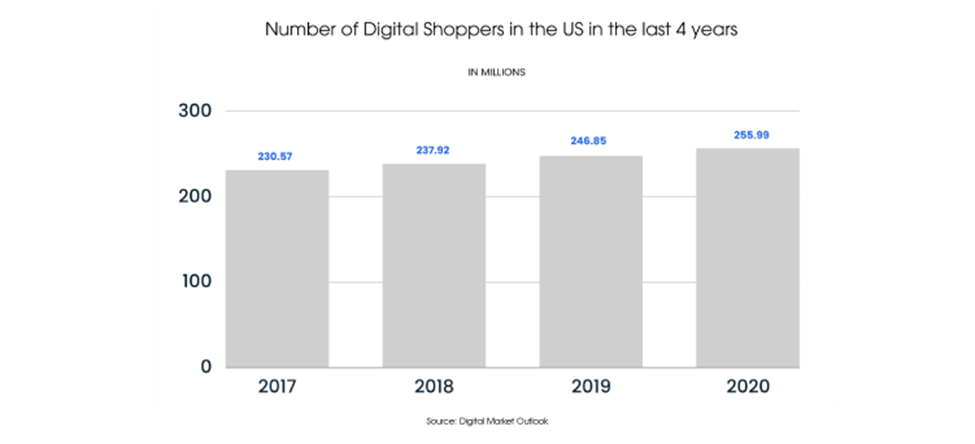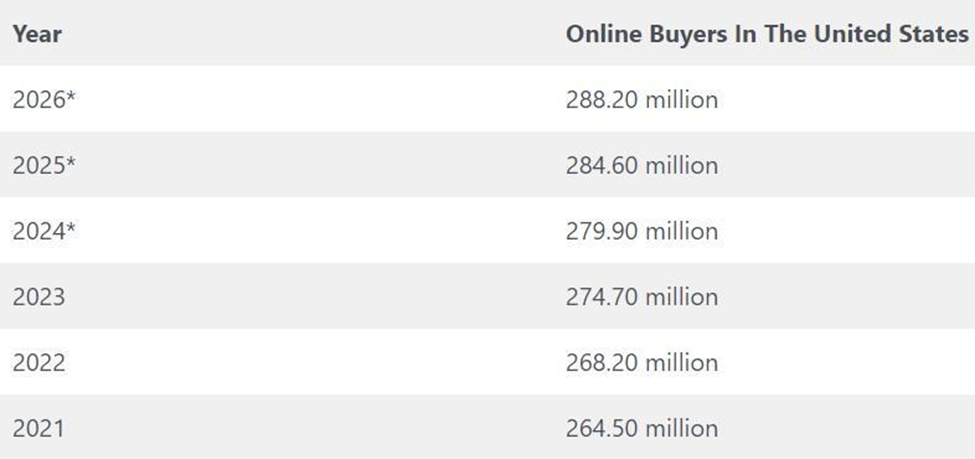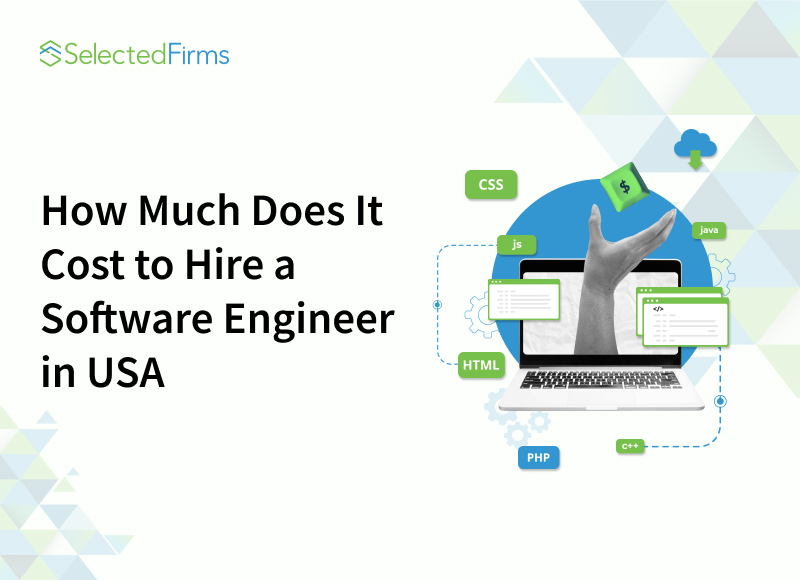Table of Contents
Get expert advice on seamlessly incorporating eCommerce into your current website. Transform your online presence today.

You have a website, but is there something important lacking, for instance, eCommerce functionality? Don't worry; we've got you covered!
Three in five (60%) among US millennials say they prefer online to in-store shopping, while more than half of Gen-Z and Gen-X consumers are inclined to do so. In general, over 50% of all Americans using the Internet prefer purchasing goods and services online over traditional brick-and-mortar retailers, according to warc.com.
Perhaps the number of digital shoppers in the United States in the last four years before COVID-19 will give you a clue of the importance of eCommerce…

And here is how it is after the pandemic, including projections for the next few years…

Businesses find that highly appealing, but eCommerce development may be costly, particularly if you want specific features and design. Retailers who wish to use already-existing websites typically seek time and money-saving options. Below, you'll find comprehensive details on how to add eCommerce to your website utilizing the latest technology.
You can include digital downloads, memberships, and subscriptions in addition to your online product sales. Whatever your reason for wanting to add eCommerce functionality to your current website, it doesn't have to be complicated.
This blog post will review three practical suggestions for quickly adding eCommerce functionality to your current website.
Pick the Right eCommerce Platform That You Can Connect to Your Website
Imagine being able to add eCommerce functionality without having to hire a developer or start from scratch. Doesn't that sound just great? That is, whether your CMS (content management system) or website builder is coupled with a B2B eCommerce platform. These platforms are like enchanted doors, enabling you to build and run a remarkable online store easily.
When choosing the ideal eCommerce software, consider your demands, goals, skill level, and budget—especially for B2B sales (Shopify, Magento, Wix…). You'll be set to soar if you have the appropriate platform!
Selecting the ideal eCommerce platform is a difficult task. Before making your choice, take into account important aspects, including your budget, your technical expertise, your goals, and any particular requirements.
While we aren't endorsing any particular platform, Shopify is praised for its plug-and-play simplicity of setup. It's an aesthetically pleasing platform with a ton of expertly created templates. There are numerous app connectors available to add further functionality. When developed with these considerations in mind by a skilled Shopify developer, the platform promises above-average security and site performance.
Shopify is still a templated solution, though its functionality and appearance are limited to its range of templates and app connections. Though not the best platform for SEO friendliness, it's still okay. Most of these issues are avoidable if you choose a seasoned Shopify marketing agency knowledgeable about the platform's SEO features and constraints.
Make Your Website eCommerce-Friendly
Let's help you optimize your eCommerce platform for success now that you've selected one that seamlessly integrates with the design of your website! Prepare to enrapture and fascinate Internet buyers with these tried-and-true strategies:
Make Error-Free Product Pages
Your goods and services ought to be highlighted! Create attractive product pages that entice customers with extensive information. Include captivating descriptions, costs, shipping choices, availability, and ratings with your high-quality photos or videos.
By making the product seem more appealing and desirable to customers, high-quality product photos can increase e-commerce sales more than anything else. Customers' trust can be increased by using clear visuals made by the best freelance photo editors for an affordable rate of as little as $5, which raises the possibility that they'll make another purchase from the online store.
A compelling product page should inspire a user to become a customer by offering all the details, guarantees, and encouragement. Individual product pages that include extensive product details, stock, availability, colour, size, sizing charts, product images, shipping prices, and product videos assist visitors in proceeding to purchase.
Customers should be able to find all the information they require on your product pages, from the most important to the little details. You should incorporate the following information on the product landing page: product specs, weight, dimensions, product description, quantities (stock availability), and product specs. In addition, you should offer options for consumers to add items to wishlists, share them on social media, and click action buttons like "Add to cart" or "Buy now".
Allowing user-generated reviews is another useful feature. Customer testimonials improve conversion rates and foster a sense of trust in your business.
Remember to include an effective CTA (call-to-action) button directing them to the checkout or shopping cart pages.
The Navigation of Products
Your products are the most crucial content on your eCommerce website. It's critical to place them in the appropriate product category and construct comprehensive product landing pages. Consider prospective clients who are trying to find a pair of pants. They find different products that are unrelated to what they are interested in or are redirected to jackets when they click on the pants category.
Users should be able to easily navigate your product selection and find the appropriate products with ease. Usage of navigation is what 70% of your consumers rely on. As a result, you should give your navigation menu top emphasis.
We'd strongly advise using breadcrumbs. They facilitate visitors' more straightforward navigation on your website. Ensure your menu is readable on small screens; arrange it in convenient spots like the left rail or at the highest part of the screen; make it interactive and clickable; and use contrasting colours for the background and text of the menu.
The product navigation aims to raise engagement and enhance the user experience. Customers are more likely to become purchasers when they are happy with the ease of navigation on your website. They'll also explore your site for longer.
Create a Streamlined Shopping Cart Process
As evident as it may appear, the shopping cart sets an eCommerce website apart from all other kinds of websites. Encouraging customers to add or delete products, return to product pages to make changes, or buy additional items is the greatest way to ensure a fantastic shopping experience.
A problematic checkout experience is why over 74% of visitors leave a website before concluding a transaction. Avoiding unforeseen expenses like additional taxes or shipping charges is another concern.
We advise having a straightforward checkout process (one-page checkout) with a picture of the products in the cart, their names, and other pertinent information (colour, price, size, etc.). We highly recommend providing website guests with the opportunity to check out as guests. Online customers (14%) who don't have the guest checkout option will abandon their carts. The conversion rate will increase with these components.
Bid adieu to moments of frustration! By offering straightforward and safe checkout pages and a shopping cart using B2B shopping cart software, you may improve your clients' experience.
Create a Streamlined Checkout Process
There should be easy access to a variety of payment options, credit cards, free shipping, and fast delivery choices. You can also use QR codes for quick and easy payment processing, further enhancing the convenience and speed of the checkout experience. Encryption is also essential! Use SSL certificates to shield their sensitive data from those bothersome hackers.
E-commerce platforms are built on the foundation of online payment systems, so your website should support them. Payment gateways improve online transactions, guard against fraud, and secure client data. Payment alternatives are essential considerations when making a transaction or closing a sales funnel. Your customers will turn to your competitors if they cannot finish online purchases using the payment method of their choice.
It's highly recommended that you incorporate other options besides credit and debit cards. There are more payment options, such as bank transfer, PayPal, and even cryptocurrency. Choose online payment methods offering extra security features and minimal transaction fees.
The checkout process becomes more effective and user-friendly with more payment alternatives; the more transactions are completed, the greater the conversion rate and income.
Include Trust Indicators That Speak "Loud"
Trust signals are precious when it comes to eCommerce. Add components that scream professionalism to your website to increase its trustworthiness.
Sadly, eCommerce websites are more vulnerable to hacking. The amount of private and financial data they handle makes them a target for fraudsters. Data loss, manipulation, and theft are all possible outcomes of hacking. Your platform should include security features for website security and data protection.
You must defend your website from typical security problems, including injections, DDoS attacks, cross-site scripting (XSS), and authentication issues. Your eCommerce business will be secure, and your clients can trust you with their data if you invest in improved website security.
We advise choosing a reputable hosting company, enforcing address verification, CVV, and strong passwords for customer accounts, adding layers of security or many layers of security, keeping an eye on transactions, scanning and upgrading your website frequently, and mandating address verification.
Branding and Logos
Unity is essential!
Select a domain name that embodies your company's distinct personality and maintains consistency with your logo across all platforms.
Search Box
A search bar is necessary since buyers are impatient these days. We strongly advise that the search bar be made type-sensitive to help users find what they're looking for more quickly. Additionally, accept mistakes and choose the closest match rather than providing no results.
Different client types do exist. Consequently, you should enable category, brand, promotion, and other search options. You may also include more filters, such as size, colour, style, price, popular products, newest products, etc.
With the exception of the checkout page, every page on your website should have a search bar. Possessing a search box on your site will enable users to begin focused searches right away, saving them time from having to go through your menu's tiers. Online buyers like conducting targeted product searches without dealing with a disrupted buying experience.
Contact Details
Be approachable!
Give them your contact information: phone number, email address, physical address (if any), links to your social media accounts, etc. For good measure, include a live chat or contact form; be accessible to customers in times of need!
Five efficient methods can be used to improve your eCommerce customer experience, which is essential for increasing sales and developing a devoted clientele.
Reviews and Testimonials
Allow others to "laud" you!
Highlight positive comments and endorsements from pleased clients. Social proof is a strong indicator of the superior quality of your goods or services.
Badges and Certificates
Clinch the deal! Display badges and certificates from respectable organizations to attest to the legitimacy and reliability of your website. Consider SSL suppliers, payment processors, security firms, and trade groups – everything that can give prospective customers assurance.
Advertise Your Web Store
It's high time for the "crowd" to come—yes, you've built it! You need traffic, conversions, and devoted consumers for your online store. A few of the marketing techniques that will fulfil your eCommerce goals are listed below:
Accept the Allure of SEO
Rank highly on Google by using SEO (search engine optimization). Ensure that every element on your website—including links, titles, descriptions, photos, and keywords—is pertinent to what people are looking for. Make informative content as well, such as blog entries or videos, that addresses their most pressing issues.
Every eCommerce platform comes with a number of pre-installed or accessible SEO capabilities as plugins to support your SEO requirements. For instance, Shopify offers a wide range of add-ons, and WooCommerce makes use of Yoast SEO. Additionally, all platforms include the normal built-in tools for managing meta descriptions, title tags, and other fundamental SEO components.
Certain platforms provide unique difficulties; Shopify's SEO problems include character restrictions on page titles and the inability to modify the URL structure. In the end, make sure the platform you choose has the integrated or add-on features you need to carry out your SEO strategy precisely as you or your SEO agency wants.
There's nothing more to consider now that you've chosen a platform that has the SEO tools you require. Correct? Wrong. A platform may be very SEO friendly, but the person developing your theme, design, and code must know SEO.
We can't emphasize this enough: regardless of the platform you select, your website will fail if your development agency is unaware of SEO and the ramifications of its work. Handling your website and SEO strategy by the same provider is the best way to ensure this. Designers, developers, and SEO should constantly work together throughout the entire process of building a website.
SMM
Grab attention with eye-catching SMM (social media marketing) campaigns on Instagram, Facebook, TikTok, and Pinterest. With eye-catching product displays and educational or amusing content, you may captivate your audience and encourage them to share what they know about your web-based business with others.
Launch Email Marketing
Never undervalue the importance of emails! Create a devoted email list of enthusiastic subscribers about what you can deliver.
Send out regular emails full of alluring deals, like discounts, to entice customers to visit your online store. For more tailored communications, divide up your email list into segments according to various factors like behaviour or demography.
Make Use of Paid Advertising
Occasionally, a small push is all you require!
Make a paid ad investment aimed at your desired clientele. Create visually appealing advertisements to draw people to your eCommerce site. To ensure that your campaigns are as successful as possible, pay special attention to important metrics such as clicks, impressions, CPC (cost per click), ROAS (return on ad spend), and conversions.
Flash Promos
Given that it has been demonstrated that customers are more likely to buy an item when it is on sale or that they will receive a gift with their purchase, flash promo alternatives are likely to boost your eCommerce sales. By implementing promos and hot deals, you may encourage customers to stay on your website longer and make more purchases.
There are many various types of promotions, including free shipping, freebies, package offers, discounts, and more. Most eCommerce companies utilise special offers in their social media, email, SMS, and other marketing campaigns. While we do not always have flash promo choices, we advocate having them around national and international holidays.
If you wish to sell your products at full price but your clients are accustomed to seeing them on your site at constant discounts, they won't buy from you immediately. They'll hold out for the exclusive offers.
Plugins
These clever, tiny software extensions can greatly improve your website by integrating eCommerce features. Using the correct eCommerce plugin is essential to set up your shop swiftly and efficiently. Setting up an online store using this plugin only takes a few clicks. These plugins cover everything from picking shipping choices to managing merchandise to handling payments.
Furthermore, many of them come with added features like customer management, analytics, and marketing tools—talk about ease!
Extra Advice for Your Online Store Enterprise
Even if you've included the aforementioned pieces of advice, your website might not make the money you're hoping for. You should continue working on your web business because it requires constant attention. We strongly advise concentrating on the client experience. Your customers determine the success or failure of your business.
When they have a great experience with your website, the ordering procedure is easy to follow, the delivery is quick, and the correspondence is clear and concise. What people say about your company and their interactions with your business will be propagated by your customers.
We now wish to support you and offer you more guidance on enhancing your online store. To raise the conversion rate, you can also use the following features and advertising strategies:
- Cross-selling is the practice of recommending related products to potential clients.
- Social media sharing is an effective way to raise brand exposure. Make the most of this chance by adding social media buttons to your product pages.
- Delivery choices: Having a range of delivery options is just as crucial as having a choice of payment methods. Having just one shipping choice can be detrimental to your company.
- Return policy: 67% of customers go over the return policy page before executing a purchase, and at least 30% of all online purchases are returned.
- An "About Us" page serves as an overview of your company. People have access to information about your goals, vision, and unique selling points.
- Add live chat to your website to enhance the user experience for visitors. When customers shop online, they can interact with your salespeople in real-time even though they can't touch or physically see the product.
- User-generated reviews and product comparisons: When consumers can see how a product is used and functions for others, they are more likely to purchase it.
Final Thoughts
This comprehensive guide lets you easily integrate eCommerce features into your current website. You can achieve online success quickly by combining the best eCommerce platform with SEO techniques and effective marketing methods.
So, embrace the phenomenon of online retail; it's an adventure not to be missed!









